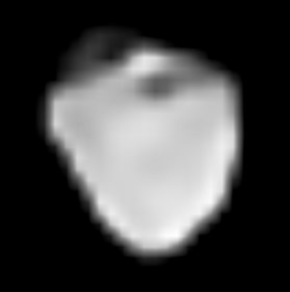 Hebe imaged by the European Southern Observatory's Very Large Telescope | |
| Discovery | |
|---|---|
| Discovered by | Karl Ludwig Hencke |
| Discovery date | 1 July 1847 |
| Designations | |
| (6) Hebe | |
| Pronunciation | /ˈhiːbiː/[1] |
Named after | Hēbē |
| A847 NA; 1847 JB | |
| Main belt | |
| Adjectives | Hebean /hiːˈbiːən/[2] |
| Symbol | |
| Orbital characteristics[3] | |
| Epoch 13 September 2023 (JD 2453300.5) | |
| Aphelion | 2.92 AU (437 million km) |
| Perihelion | 1.93 AU (289 million km) |
| 2.43 AU (364 million km) | |
| Eccentricity | 0.2027 |
| 3.78 yr (1379.85 d) | |
Average orbital speed | 18.93 km/s |
| 144.0° | |
| Inclination | 14.736° |
| 138.63° | |
| 10 March 2022 | |
| 239.59° | |
| Earth MOID | 0.97 AU (145 million km) |
| Proper orbital elements[4] | |
Proper semi-major axis | 2.4252710 AU |
Proper eccentricity | 0.1584864 |
Proper inclination | 14.3511092° |
Proper mean motion | 95.303184 deg / yr |
Proper orbital period | 3.77742 yr (1379.702 d) |
Precession of perihelion | 31.568209 arcsec / yr |
Precession of the ascending node | −41.829042 arcsec / yr |
| Physical characteristics | |
| Dimensions | 205 km × 185 km × 170 km[5][6][7] |
| 195±3 km[8] 186 km[5] | |
| Flattening | 0.25[a] |
| Mass | (1.24±0.24)×1019 kg[8] (1.27±0.13)×1019 kg[b][9] |
Mean density | 3.18±0.64 g/cm3[8] 3.77±0.43 g/cm3[9] |
Equatorial surface gravity | ~0.079–0.099 m/s2 |
Equatorial escape velocity | ~0.127–0.135 km/s (457–486 km/h) |
| 0.3031 d[10] | |
Equatorial rotation velocity | 22.2–24.6 m/s[c] |
| 0.268[8][6] | |
| Temperature | ~170 K max: ~269 K (−4°C) |
| S | |
| 7.5[11] to 11.50 | |
| 5.61[3] | |
| 0.26" to 0.065" | |
6 Hebe (/ˈhiːbiː/) is a large main-belt asteroid, containing around 0.5% of the mass of the belt. However, due to its apparently high bulk density (greater than that of the Moon), Hebe does not rank among the top twenty asteroids by volume. This high bulk density suggests an extremely solid body that has not been impacted by collisions, which is not typical of asteroids of its size – they tend to be loosely-bound rubble piles.
In brightness, Hebe is the fifth-brightest object in the asteroid belt after Vesta, Ceres, Iris, and Pallas. It has a mean opposition magnitude of +8.3, about equal to the mean brightness of Saturn's moon Titan,[12] and can reach +7.5 at an opposition near perihelion.
Hebe may be the parent body of the H chondrite meteorites, which account for about 40% of all meteorites striking Earth.
- ^ Noah Webster (1884) A Practical Dictionary of the English Language
- ^ Gabriel Nisbet (1733) Caledon's Tears
- ^ a b "JPL Small-Body Database: 6 Hebe". Jet Propulsion Laboratory. Retrieved 20 September 2023.
- ^ "AstDyS-2 Hebe Synthetic Proper Orbital Elements". Department of Mathematics, University of Pisa, Italy. Retrieved 1 October 2011.
- ^ a b Jim Baer (2008). "Recent Asteroid Mass Determinations". Personal Website. Archived from the original on 2 July 2013. Retrieved 28 November 2008.
- ^ a b Supplemental IRAS Minor Planet Survey Archived 23 June 2006 at archive.today
- ^ J. Torppa et al. Shapes and rotational properties of thirty asteroids from photometric data, Icarus, Vol. 164, p. 346 (2003).
- ^ a b c d e P. Vernazza et al. (2021) VLT/SPHERE imaging survey of the largest main-belt asteroids: Final results and synthesis. Astronomy & Astrophysics 54, A56
- ^ a b James Baer, Steven Chesley & Robert Matson (2011) "Astrometric masses of 26 asteroids and observations on asteroid porosity." The Astronomical Journal, Volume 141, Number 5
- ^ Planetary Data System Small Bodies Node, lightcurve parameters Archived 14 June 2006 at archive.today
- ^ Donald H. Menzel & Jay M. Pasachoff (1983). A Field Guide to the Stars and Planets (2nd ed.). Boston, MA: Houghton Mifflin. pp. 391. ISBN 0-395-34835-8.
- ^ The Brightest Asteroids Archived 2008-05-11 at the Wayback Machine
Cite error: There are <ref group=lower-alpha> tags or {{efn}} templates on this page, but the references will not show without a {{reflist|group=lower-alpha}} template or {{notelist}} template (see the help page).